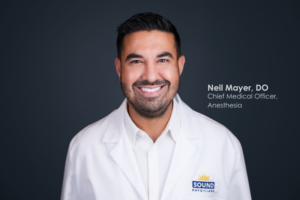February 8, 2024
The foundation for a successful anesthesia practice
By Neil Mayer, DO, Chief Medical Officer, Anesthesia
 As Sound’s new Chief Medical Officer for Anesthesia, my primary focus is on providing patients with the highest-quality care for better outcomes — and sharing successes across our national footprint to amplify best practices.
As Sound’s new Chief Medical Officer for Anesthesia, my primary focus is on providing patients with the highest-quality care for better outcomes — and sharing successes across our national footprint to amplify best practices.
Our patients are the why of what we do. Developing a better way of practicing perioperative medicine — our how — is essential to achieving that higher level of care that patients deserve.
As a practicing anesthesiologist and experienced physician leader, I understand the challenges facing clinicians in our field. Like you, I’m always in search of ways we can be better at innovating, elevating, and standardizing our practice to better serve not only our patients, but also our surgeons, hospital partners, and each other. For me, there are three areas of focus that, when done well, are foundational to a successful anesthesia practice.
Staffing: Well-trained clinicians, flexible models
First and foremost, being able to accommodate case volume to meet the needs of our facility partners is paramount to success. When we started our anesthesia practice in 2019, we had four programs. Today, we have more than 60. We’ve been able to scale to meet the needs of our partners by replicating a successful model that understands what physician anesthesiologists and CRNAs want from their practice. We have also been nimble in tailoring our practices to remain successful in a rapidly evolving healthcare climate.
We know anesthesia clinicians want to practice at the top of their license, and they can do so in an environment that affords collaboration while allowing them to lean into their respective expertise. Being able to recruit and retain higher-level clinicians is essential to achieving higher-quality standards.
Within our medical group, we understand the importance of each role — whether physician anesthesiologist, CRNA, or administrative support — and when there’s cohesiveness, we’re able to do right by our patients with seamless, efficient care.
Flexible care models give us the ability to create programs that work best for our partners. When establishing a new professional relationship, sharing ownership of that transition provides visibility into our management and reassures our hospital partners that we are building a full-time, stable team the right way. Additionally, once a program is up and running, facility needs may change, and flexibility in adapting to new opportunities is essential for long-term success.
Sustainability: Transparency is key
With labor expenses steadily rising over the past few years, the vast majority of hospital programs are heavily subsidized. Being transparent with the cost of labor and operations is essential to building trust. We find partners want to be involved in financial conversations and have a better understanding of the anesthesia landscape when they’ve got a seat at the table.
Bringing our hospital partners along on the economic journey helps eliminate the gray area that sometimes occurs when there isn’t transparency. It also helps develop shared understanding and ownership of what it really costs to run a practice dedicated to high-quality care.
There’s tremendous value in the practice management expertise you get from a medical group with a national footprint. We’ve learned some lessons along our path to growth that have shown us ways to work more efficiently and effectively, whether it’s one hospital or many within a system. For example, breaking down the financials of short-term savings vs. long-term expenses associated with improved patient outcomes and team stability can help our partners see the bigger picture and set us up for an enduring partnership
Value: Clinical excellence matters
Everything we do is about driving toward clinical excellence for each of the groups we serve: our patients, hospital partners, surgeons, and clinical teammates.
The true measure of success for anesthesia clinicians — and for our hospital and surgeon partners — is the quality of care we provide, and whether it delivers a better outcome and experience for our patients. Higher-quality care comes from focusing on the factors we can control, such as start time, multimodal analgesia, and the patient’s experience with comfort and safety. When we miss the mark, it’s important to ask why and get to the root of what’s not working.
Building a better practice takes time, investment
Solid relationships between clinicians practicing shoulder to shoulder every day, and between the anesthesia team and hospital staff, are at the heart of a successful practice. Forging those kinds of relationships takes an investment of time and understanding. Building trust within those relationships happens through bringing on the right people, keeping the lines of communication open, and being able to pivot when necessary. Where morale is fraying or clinical operations aren’t running smoothly, sometimes it’s about remodeling, recalculating, and finding a new path forward. Being flexible and quick to evolve gives us space to do what we do best: bring better care to the bedside for each of our patients.
